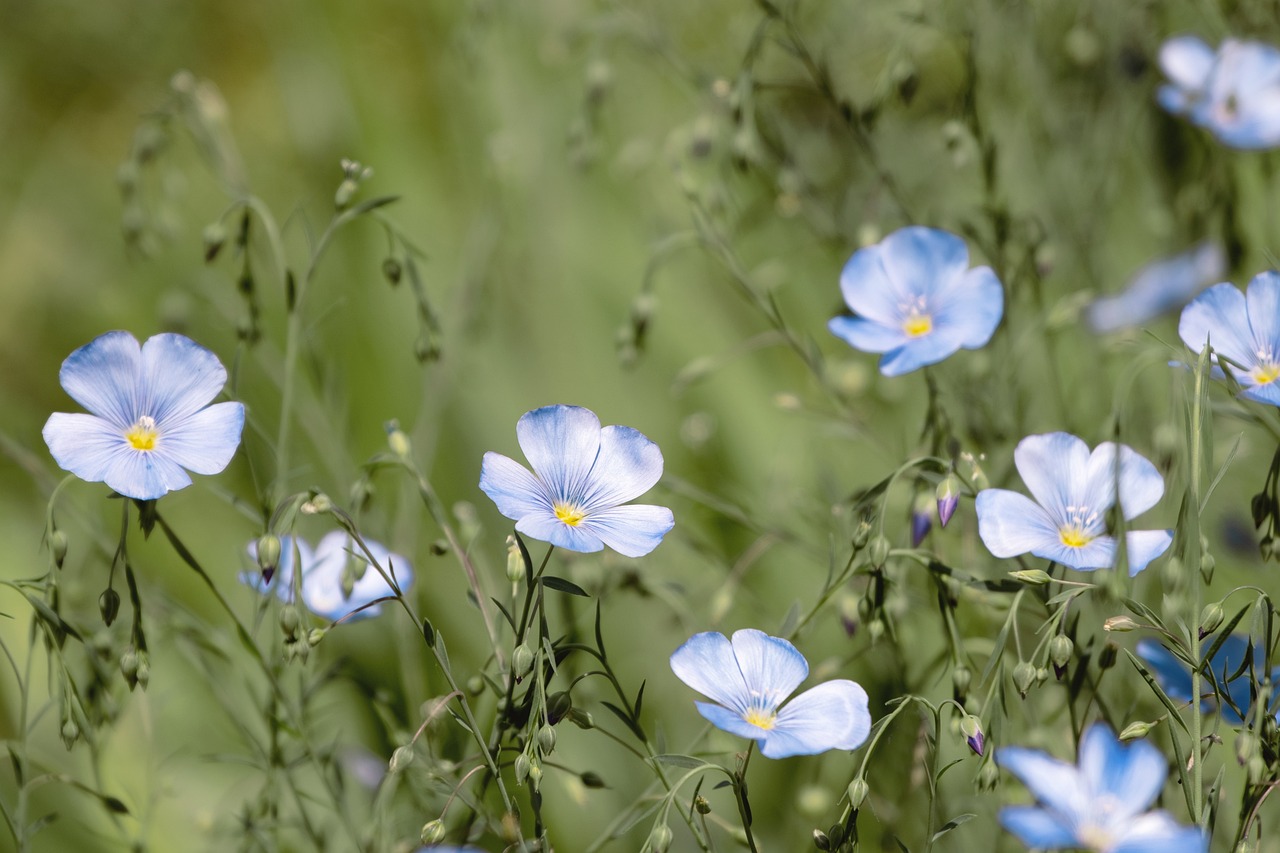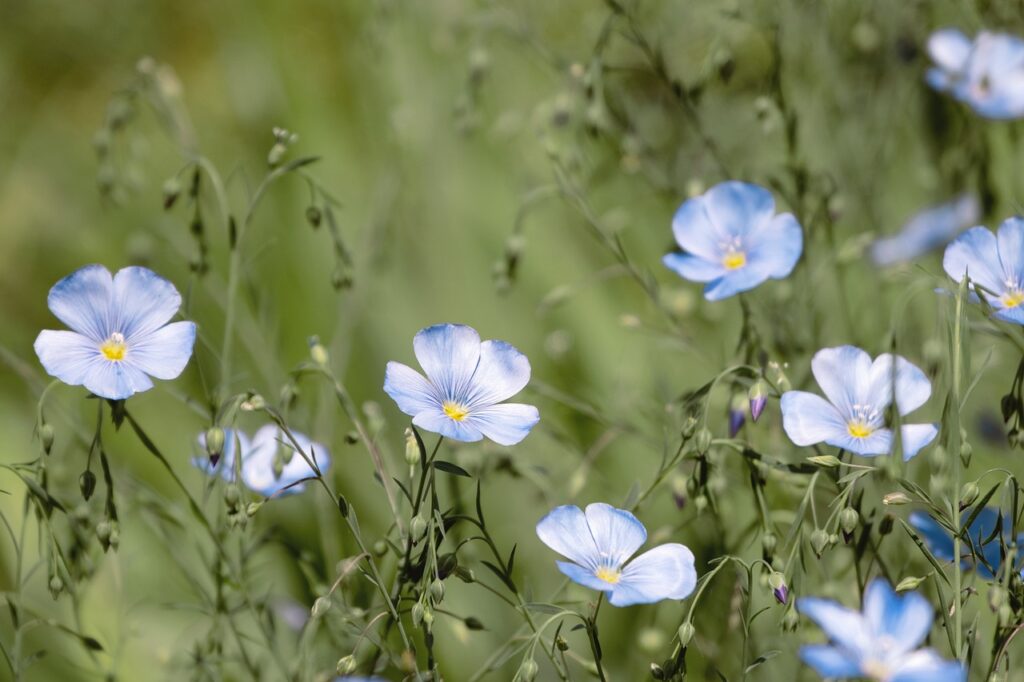
From Pixabay, Image by NickyPe, Content License
Saint Helena
Flax
Linum usitatissimum

From Pixabay, Image by NickyPe, Content License
General Description / Cultural Significance
Flax (Linum usitatissimum) is a highly versatile plant with a long history of cultural and economic significance across the world. This tall, slender plant typically grows between 3 to 5 feet (0.9 to 1.5 meters) in height, with narrow, lance-shaped leaves and delicate blue flowers that bloom in the summer. Its small, oval seeds have a smooth, brownish appearance and are widely valued for their nutritional and medicinal properties. Flax is primarily known for its fibers, which are extracted from the stem to produce linen—a durable and breathable textile that has been used for millennia in clothing, household items, and even as a sacred burial fabric in ancient civilizations. Additionally, flax seeds are rich in omega-3 fatty acids, fiber, and lignans, making them a staple in health-conscious diets and traditional medicine. Linseed oil, derived from the seeds, has long been used in cooking, cosmetics, and industrial applications such as wood finishing and paint production.
In Saint Helena, flax played a pivotal role in shaping the island’s economy and social fabric for nearly six decades. Introduced in the early 20th century, flax cultivation quickly became the backbone of the island’s workforce, with much of the population directly or indirectly reliant on its production. From 1907 until its decline in 1966, flax was Saint Helena’s primary economic driver, sustaining local livelihoods and providing a rare avenue for global trade. The island’s rugged terrain, though limiting for traditional agriculture, proved well-suited to flax cultivation, allowing it to thrive in the challenging conditions.
The peak of the flax industry coincided with a period of relative prosperity for Saint Helena. During both World Wars, the demand for durable fibers surged, and Saint Helena’s flax exports became vital for producing ropes, nets, and canvas products used in military operations. The industry also played a crucial role in shaping Saint Helena’s rural landscape, with large swathes of the island dedicated to flax plantations, and factories established to process the fiber for export. At its height, approximately 3,000 acres of land were devoted to flax, and over 400 islanders were employed in the industry, making it one of the most significant economic endeavors in the island’s history.
Despite its economic benefits, the flax industry was never truly stable. Global competition, fluctuating market prices, and the rise of synthetic fibers led to growing financial difficulties. The final blow came when the British Post Office, one of the main buyers of Saint Helena’s flax for producing mailbags, switched to synthetic alternatives, effectively collapsing the industry. The combination of high production costs and expensive shipping rates meant that flax was no longer a viable economic pursuit. As a result, flax cultivation on Saint Helena was abandoned, and with it, an essential chapter of the island’s history came to an end.
Though the industry is now defunct, the cultural imprint of flax remains deeply embedded in Saint Helena’s identity. Today, remnants of the once-thriving industry can still be seen in the abandoned processing plants and the fields where flax once grew abundantly. Some islanders recall stories from their ancestors who worked in the flax fields, processing plants, or shipping operations. The industry also shaped local craftsmanship, with flax ropes and textiles once being integral to daily life. While modern Saint Helena has moved beyond flax as an economic driver, the legacy of this industry endures as an essential part of the island’s history.
Climate Change / Conservation Status
Since the demise of the flax industry in 1966, there have been no large-scale attempts to revive it on Saint Helena. While some have suggested that reintroducing flax cultivation could bring economic benefits, significant obstacles remain. The high costs of production, coupled with the challenges of exporting from such a remote location, make large-scale flax farming financially unviable in the modern global economy.
Beyond economic concerns, climate change poses additional threats to any potential flax revival and to Saint Helena’s broader ecosystem. The island, located in the South Atlantic Ocean, has already begun experiencing the impacts of a changing climate, including rising temperatures and shifting weather patterns, increased frequency of storms and extreme weather, soil degradation, invasive species, water scarcity, and resource limitations
Although climate change presents challenges, it has also sparked renewed interest in sustainable land management and conservation efforts on Saint Helena. Some conservationists suggest that, rather than reintroducing flax purely for commercial purposes, the plant could be reestablished on a small scale to help prevent soil erosion and promote ecological restoration. If managed correctly, flax cultivation could serve a dual purpose—honoring the island’s cultural heritage while supporting local conservation efforts.
With the global movement towards natural and biodegradable fibers, some argue that Saint Helena’s flax could once again find a niche market, especially as demand for sustainable textiles rises. However, for this to be feasible, significant investments in infrastructure, research, and market development would be required.
In the absence of a revived flax industry, Saint Helena is turning towards ecotourism, conservation, and heritage preservation as alternative economic strategies. The island’s unique biodiversity, including its endemic plant species, and its rich history offer opportunities for sustainable tourism and educational initiatives. Protecting the remaining native vegetation and endemic species is a growing priority, with efforts focused on preserving Saint Helena’s fragile ecosystems from the pressures of climate change and human activity.
Whether as an economic crop or a historical touchstone, the legacy of flax in Saint Helena endures, offering insights into the island’s past and potential avenues for its future. As such, flax remains a symbol of resilience and heritage for the islanders.
Alternate Names
Alasi
Sources
Robin@ripetungi.com. “The Flax Industry. St Helena Island.” St Helena Island, sthelenaisland.info/the-flax-industry/. The Editors of Encyclopedia Britannica. “Flax.”
Encyclopedia Britannica, Encyclopedia Britannica, inc., www.britannica.com/plant/flax.

